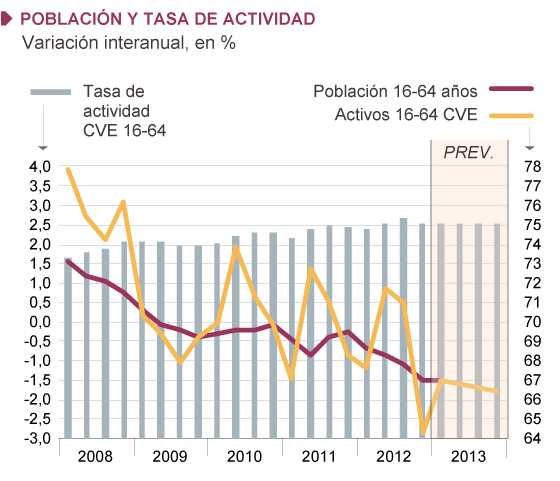スペインの2012年の失業率は26'2%の約600万0000人の失業者。2013年はもっと悪くなる?!
OPINIÓN
El paro en 2012 y perspectivas para 2013
Ni la economía en general ni el mercado laboral en particular dan signos de mejora
Ángel Laborda 27 ENE 2013 - 00:01 CET
ha acelerado hasta el 5,5% en el último.
OPINION
Unemployment in 2012 and prospects for 2013
Neither the overall economy and the labor market in particular are showing signs of improvement
Angel Laborda 27 ENE 2013 - 00:01 CET
The first and last quarters of the year tend to be quite unfavorable for the labor market, which is due to the seasonality of many economic activities in Spain, more pronounced than in other countries. This phenomenon and the harsh economic situation being experienced by the Spanish economy foreshadowed a sharp rise in unemployment in the fourth quarter of last year, to over six million people. In the end, this fateful figure has not been reached, but we were at the gates. The sobrepasaremos in the first quarter of this year. What we surpassed a few quarters ago and is the high of the unemployment rate of the Labour Force Survey (LFS), which maintains its upward trend and reached 26% in the last quarter.
The loss of employment in the service sector has been higher than in 2009 by layoffs in the public sector "
With being bulky (187,400 people), the increase in unemployment was significantly lower than expected. But this should not be interpreted as the labor market, and therefore the economy as a whole, has begun to show signs of improvement. Rather, the key variable to analyze the labor market, employment, registered a higher than expected drop to the point that the decline in GDP of six tenths of a percent that has advanced the Bank of Spain for the last quarter of 2012 would be an understatement. The quarterly fall of employed, seasonally adjusted and annualized rates of 4% recorded in the central quarters of the year and has accelerated to 5.5% in the final.
Sources: INE (EPA) and Func (seasonally adjusted and forecasts). Graphics produced by A. Laborda. / COUNTRY
For the full year, the average number of employed was lower by 4.5% than the previous year (822,600 people), the second largest drop in the time series after 2009. No sector was spared job losses: in agriculture, 0.9% in industry, 4.9% in construction, 17.6%, and in services, 3.3%. In this case the voltage drop is greater than in 2009, which is that, unlike then, the public has joined the template setting process. As seen in the chart below left, public sector employees fell by 7% (219,000 people) over 2012, compared to 5.9% (685,000 people) in the private sector. Also watch until mid-2011 the public sector was increasing their workforces at a high rate, which was one of the causes of the deficit is out of control, with the consequences that we are now paying.
The increase in unemployment in the last quarter was well below the decline in employment, which reached 363,400 workers (about 250,000 seasonally adjusted). This was made possible by lower assets 176,000 people. As seen in the upper left graph, the evolution of this variable is quite volatile, but is explained by the population of working age. In recent quarters this has accelerated rate of decline over the most recent estimates of the INE, which must be explained by greater output immigrants. To this has been added the labor market withdrawal especially young, either discouraged or because they have gone out of Spain to make a living. That is, is declining working-age population and the percentage of it that remains active (activity rate).
To forecast the short-term behavior of emigration or the activity rate is complicated and uncertain, and it depends largely on the evolution of unemployment. The projections for 2013 are part of the hypothesis that the working-age population continues to accelerate its pace of decline slightly and that the activity rate is stabilized (so far has been rising). The other variable is employment, which is determined by the GDP and the apparent labor productivity. Forecasts indicate that the GDP will continue to fall until the third quarter and that slows productivity, which would lead to declines in employment throughout the year, although at a decreasing rate. The result of all this in terms of unemployment is that, seasonally adjusted, continue to increase in the first two quarters of the year and then stabilize at a rate of 26.7% of the working population, or slightly above six million people.
Angel Laborda situation is director of the Foundation of Savings Banks (Func)
Europe does not help
Last week published data external merchandise trade in November 2012. We tend to remember in this column that the foreign trade monthly figures are erratic, and the last four months are a good example. In November, exports, seasonally corrected constant prices were 3.8% lower than the previous month and 2.7%, also lower than the same month last year.
But by taking the average of October and November are obtained growth of 0.7% compared to the average of the third quarter (2.7% annualized) and 2.9%, respectively. Exports, therefore, continue to grow, but lessen their pace, which is entirely due to the drop in to the EU. The accumulated until November, total constant prices increased a modest 1.9%, and those for outside the EU, 10.3%, but those for EU countries fell by 2%. By far, the latter due to falling car sales.

0 件のコメント:
コメントを投稿